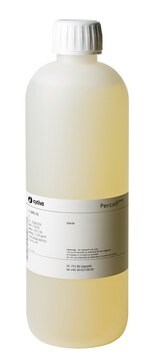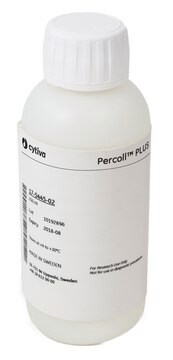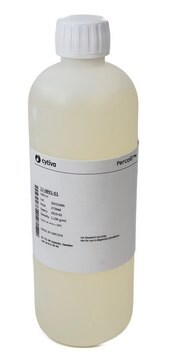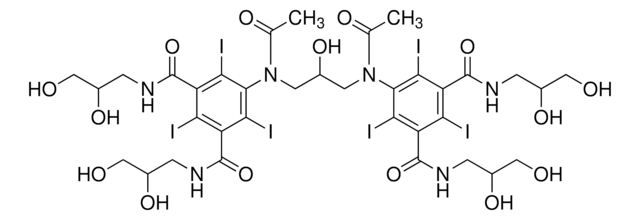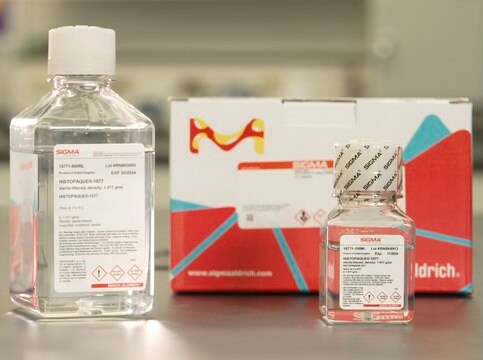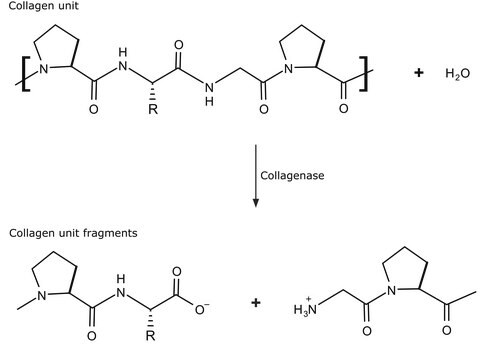推荐产品
一般描述
应用
- 新生大鼠心室心肌细胞
- 血液样本中的白细胞
- 小管周围肌样(PM)细胞
特点和优势
- 低渗透压允许对生理条件进行精确调整,而不会受到介质的明显干扰。
- 与活细胞和病毒兼容,并允许分离和恢复完整的,完全活跃的系统。
- 对生物膜不渗透,在离心过程中不改变颗粒的浮力密度。
- 在离心过程中自发形成的梯度允许在离心管中混合大量样品。
- 低粘度导致快速形成梯度和颗粒分离。
- 大多数沉降系数大于60S的生物颗粒可以在Percoll梯度中成功分离。
法律信息
相关产品
储存分类代码
12 - Non Combustible Liquids
WGK
nwg
闪点(°F)
Not applicable
闪点(°C)
Not applicable
个人防护装备
Eyeshields, Gloves
分析证书(COA)
输入产品批号来搜索 分析证书(COA) 。批号可以在产品标签上"批“ (Lot或Batch)字后找到。
已有该产品?
为方便起见,与您过往购买产品相关的文件已保存在文档库中。
难以找到您所需的产品或批次号码?
如何查找产品货号
在网站页面上,产品编号会附带包装尺寸/数量一起显示(例如:T1503-25G)。请确保 在“产品编号”字段中仅输入产品编号 (示例: T1503).
示例
其它示例:
705578-5MG-PW
PL860-CGA/SHF-1EA
MMYOMAG-74K-13
1000309185
输入内容 1.000309185)
遇到问题?欢迎随时联系我们技术服务 寻求帮助
如何查找COA批号
批号可以在产品标签上"批“ (Lot或Batch)字后面找到。
Aldrich 产品
如果您查询到的批号为 TO09019TO 等,请输入去除前两位字母的批号:09019TO。
如果您查询到的批号含有填充代码(例如05427ES-021),请输入去除填充代码-021的批号:05427ES。
如果您查询到的批号含有填充代码(例如 STBB0728K9),请输入去除填充代码K9的批号:STBB0728。
未找到您寻找的产品?
部分情况下,可能未在线提供COA。如果搜索不到COA,可在线索取。
Can you help me calculate gradients for Percoll®, Product P1644?
The product information sheet (under Documents, above) has an equation for calculating density of a given solution.
When using Product P1644, Percoll®, what density should I use for my particular system?
The product information sheet (under Documents, above) has a table of densities for different organelles and cell types.
Is there a "best" salt solution to use with Product P1644, Percoll®?
Percoll can be used with various salt formulations (PBS, 1.5 M NaCl, HBSS, etc.). Physiological saline and balanced salt solutions can be suggested. Sucrose is included to prevent aggregation. You can find detailed preparation instructions on the product information sheet (under Documents, above) for this product.
Can Percoll®, Product P1644, be autoclaved?
Percoll can be autoclaved, but this must be done without any salts or sucrose present.
Which document(s) contains shelf-life or expiration date information for a given product?
If available for a given product, the recommended re-test date or the expiration date can be found on the Certificate of Analysis.
How do I get lot-specific information or a Certificate of Analysis?
The lot specific COA document can be found by entering the lot number above under the "Documents" section.
How do I find price and availability?
There are several ways to find pricing and availability for our products. Once you log onto our website, you will find the price and availability displayed on the product detail page. You can contact any of our Customer Sales and Service offices to receive a quote. USA customers: 1-800-325-3010 or view local office numbers.
What is the Department of Transportation shipping information for this product?
Transportation information can be found in Section 14 of the product's (M)SDS.To access the shipping information for this material, use the link on the product detail page for the product.
What is the difference between Percoll® Products P4937 and P1644?
Product Nos. P1644 and P4937 are both Percoll. Product No. P4937 has additional testing for use in cell culture.
My question is not addressed here, how can I contact Technical Service for assistance?
Ask a Scientist here.
我们的科学家团队拥有各种研究领域经验,包括生命科学、材料科学、化学合成、色谱、分析及许多其他领域.
联系技术服务部门
